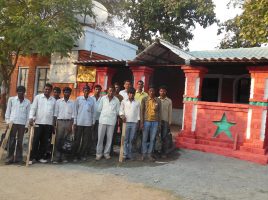Habitat as Enabler of Rural Livelihoods
India remains predominantly a rural country with two third of its population and 70% of the workforce residing in rural areas. Growth and development of rural India will remain a key to overall growth of the country. The key economic driver in rural areas – agriculture – is, beset by many risks, aggravated by absence of efficient market structure and inadequate post harvest institutional arrangements. The situation is further compounded by sub-optimal size of agricultural holdings. Small and marginal land holdings contribute to 80% of Indian agriculture. Such small holdings, with potential for further subdivision, are unlikely to be economically viable by themselves, let alone generate growth and income for the farming population to lift them out of the subsistence trap. It is therefore essential to enable other platforms to mobilise economic activity that would provide employment and income to the rural population in addition to farm-based activity.
Massive shift of population from farm-based activity to industrial/urban centres is unlikely to provide any solution, given the emerging trend of high automation and low-employment in manufacturing and high level of skills required in the service sector. The urban sector in India is faced with burgeoning problems resulting from poor infrastructure and can ill-afford a large influx from rural areas. The key therefore is to raise the productive potential of the rural population in rural areas itself.
Housing is one of the means of unlocking this productive potential. Apart from the fact that rural construction accounts for nearly half of the total building activity in the country, housing is a potent means of unlocking the latent capital of rural areas – Physical Capital (in terms of secure, disaster resilient and healthy shelter), Natural Capital (by using sustainable technologies and materials), Economic Capital (shelter with platform for value addition through local skills, local materials and labour, employment generating), Human Capital (in terms of preventive health, by providing a stable platform for education, creativity) Social Capital (peaceful, cooperative communities). In fact, housing is not what it is but what it enables!! It enables unlocking of all kinds of potential if looked at as comprehensive habitat for transforming life in rural areas.
The current state of play is that rural areas are characterised by poor infrastructure and civic amenities. India has set itself ambitious goals under “Housing for All by 2022”. There is a need to look beyond “housing as shelter” and to adopt a sustainable habitat development approach. With sustainable habitat as the transforming factor, all aspects of housing, along with basic amenities and other public infrastructure will require to be taken into consideration. This would entail sustainable means of ensuring proper sanitation, clean water, domestic energy amenities, economic and social public infrastructure (community facilities and livelihood space) and associated infrastructure. Thus, the immense capital of rural India in its various forms i.e. Physical, Natural, Financial, Human, Social would come into play, resulting in a rising tide of sustainable growth and poverty alleviation.
“The future of India lies in its villages”- a famous observation made by the Father of the Nation many decades ago, may still hold the secret for sustaining India’s growth story.
Shri Jitesh Khosla, (khosla.jitesh@gmail.com) IAS Retd. (Former Chief Secretary, Government of Assam) (Senior Advisor, DA) and Srijani Hazra (shazra@devalt.org) Manager, DAThe views expressed in the article are those of the authors’ and not necessarily those of Development Alternatives.
References:
http://niti.gov.in/writereaddata/files/document_publication/Rural_Economy_DP.pdf
https://www.livemint.com/Opinion/amEFrnhIeOhL224XdoV1rJ/The-rural-economy-is-not-just-about-farming.html






Leave a Reply